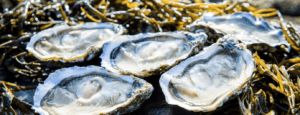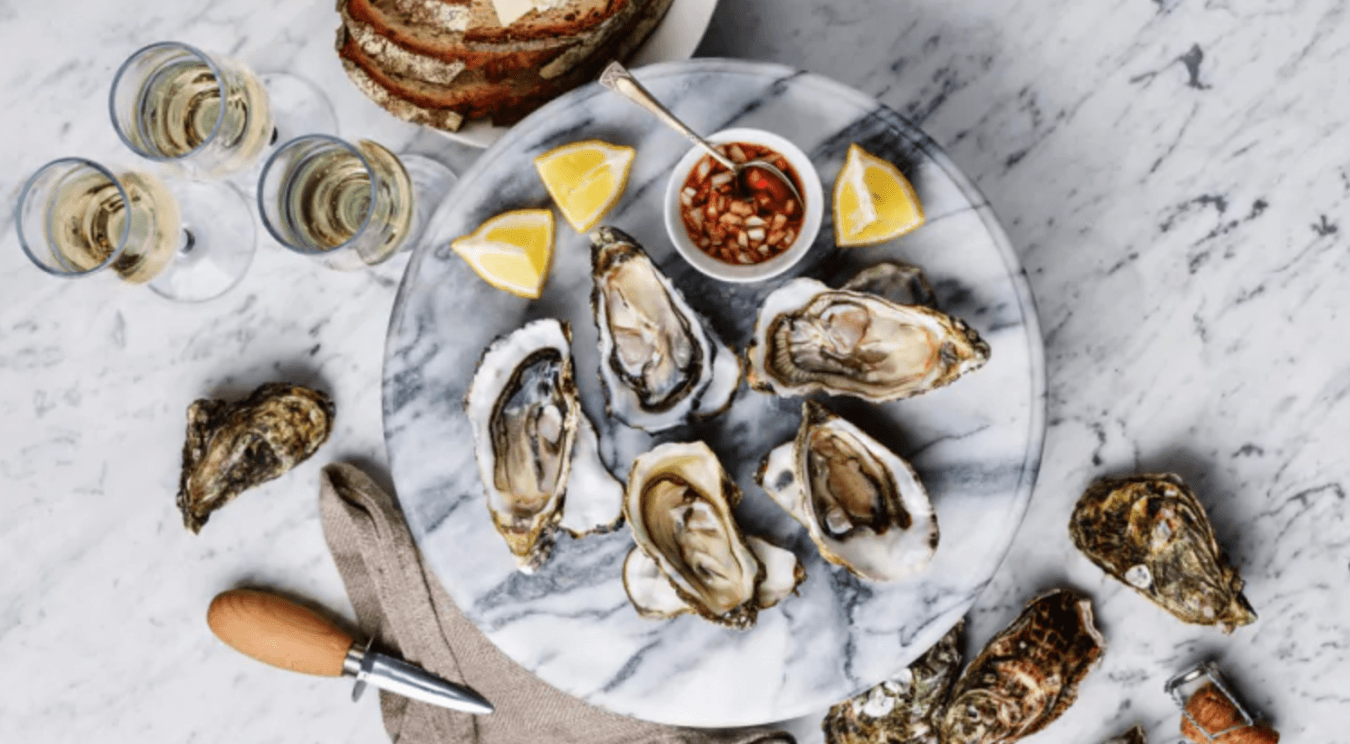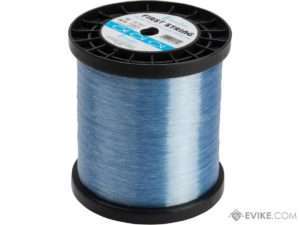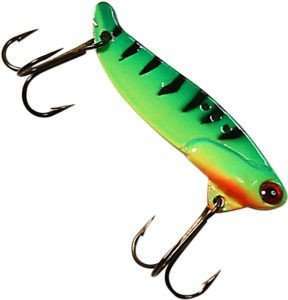Welcome to the home of the world-renowned Carlingford Oyster. Oysters have thrived in Carlingford for many many centuries. With the upcoming Carlingford Oyster Festival reaching it’s 40th Anniversary we at Visit Carlingford want to pay homage to the humble Oyster in every way possible.

Nature has created the ideal location to grow oysters right on our doorstep in Carlingford Lough and Carlingford Oyster Company, family-run business has been farming oysters in the clean grade ‘A’ classification waters of Carlingford Lough since 1974.
Take a look at the video for a little insight into the process…
How It All Began
On a misty morning in the late 1960’s Peter Louët Feisser sailed into Carlingford Lough on a wooden yacht, built with his own hands, accompanied by his wife Anna and two chickens. He was enchanted by the Loughs natural beauty and seduced by the allure of the Irish way of life.
Always attracted by the sea, he was inspired in 1974 to begin growing oysters after hearing a broadcast on BBC radio 4. Now in his 80’s Peter can still be found early in the morning out on the oyster farm at low tide perfecting new growing techniques devised to create the ultimate Carlingford Oyster.
Oyster farming offers a unique quality of life governed by the cyclical rhythm of natures seasons and tides. The next generation are now following in the footsteps of Peter, with his son Kian and wife Mary building on that romantic notion from 1974.
All of our customers will be familiar with the friendly voice of Peter’s youngest daughter Charm who manages our sales department and during the holidays Peter’s grand children will be found helping out around the farm learning the family business and earning some pocket money.
How Do You Eat Yours?
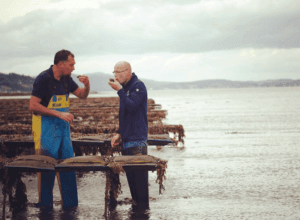
The famous question, baked or raw? Well, we have two recipes below for your tastebuds…
RAW

Ingredients:
- 12 oysters
- Crushed ice or rock salt
- Cucumber Mignonette
Method:
1. Scrub the oysters under cold water with a stiff brush to remove the dirt, especially in the hinge area where mud has a tendency to get trapped.
2. Find a durable thick cloth and fold it over several times to create a square; this will steady the oysters as you shuck them and also protect your hand.
3. Using the towel as a mitt, place the oyster, cup-side down in the palm of your towel-covered hand with the hinge facing you; have a small bowl handy to catch the delicious juice. Insert the tip of an oyster knife or dull butter knife as far into the hinge as it will go; don’t jab it in there or you could break the shell.
4. With gentle force, twist the knife back and forth to pry the shell open.
5. Using the knife, cut the muscle away from the top shell, bend the shell back, and discard it.
6. Run the knife underneath the oyster to detach it completely, but leave it in its shell.
7. Tip out the briny liquor into the bowl and pour it back over the shucked oysters. Nestle the oysters in a bed of crushed ice or rock salt to keep them steady. Spoon the cucumber mignonette on top and serve as part of a raw shellfish bar.
Cucumber Mignonette Sauce:
1 cup rice wine vinegar
1 shallot, minced
1-inch piece fresh ginger, peeled and grated
1/2 hothouse cucumber, peeled and minced
Several turns freshly ground black pepper
1 handful fresh cilantro leaves, chopped
8. In a small bowl, combine the rice wine vinegar, shallots, ginger, cucumber, black pepper, and cilantro; mixing with a fork. Cover and chill for at least 1 hour or up to the day before you plan to serve, to allow the flavors to come together. Serve with raw oysters and clams.
Yield: 1 cup
To eat a raw oyster you will need to do the following:
1. Pick up one of the oysters by the shell.
2. Use the cocktail fork that comes with your order to detach the oyster from its shell.
3. When you are sure the oyster is no longer attached to the shell, put the edge of the shell against your bottom lip.
4. Slurp the oyster into your mouth.
A few questions you might have:
Should I swallow the oyster or chew it? You should chew it! How else will you know what it tastes like?
Should I use any type of seasoning? Some people like to put seasoning on their oysters before eating them. Popular choices include cocktail sauce, Tabasco sauce, and lemon juice.
ENJOY!
BAKED
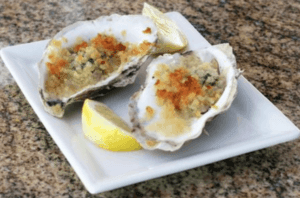
These delicious oysters are baked with butter, cheese, garlic and pepper.
Ingredients:
- 2 kilos fresh oysters
- ½ cup grated cheese
- ¼ cup minced fried garlic
- Dash of pepper
- ¼ cup melted butter
1. Open oysters. Clean the part with the meat and discard the other shell.
2. Top each shell with cheese, garlic, and butter then sprinkle with a dash of pepper.
3. Place on a baking tray and bake for 15 minutes at 350°F or until golden brown.
4. Serve immediately with a slice of lemon.

10 Oyster Facts You Didn’t Know
Just for a little fun, we have found 10 interesting facts about Oysters, these are definitely worth a read!
- Oysters change their gender.
One of the most interesting oyster facts is that oysters change their sex during their lives, starting as males and usually ending as females. - An oyster can filter 1.3 gallons of water per hour.
Oysters filter water in through their gills and consume food, like plankton, in the process. Oysters can maintain the balance of a marine ecosystem by reducing excess algae and sediment that can lead to hypoxia, or low oxygen levels, causing other marine life to die. The oyster population of Chesapeake Bay used to filter the entire water volume of the bay in just three days. - Oysters are shaped by their beds.
Once an oyster attaches to a bed (a surface occupied by a group of oysters), it grows and forms around the surface it attaches to as well as the other oysters around it. - Pearls and the relationship with Oysters
All oysters are capable of producing pearls, but not the shiny, pretty pearls of value. In fact, most pearls are harvested from an inedible type of oyster as well as from freshwater mussels. - Oysters have been around for thousands of years.
Oysters have been eaten by humans since prehistoric times and cultivated at least since the times of the Roman Empire. The Roman Sergius Orata was the first person known to cultivate oysters by building a system that could control water levels. - Most American oysters are of the same species.
Get your oyster facts straight — oysters harvested from the Gulf of Mexico, Chesapeake Bay and off the coast of Virginia are all the same oyster, Crassotrea virginica. This oyster species is native to the Gulf Coast and the East Coast. However, this does NOT mean they all taste the same. - Gulf oysters used to have different names.
Other than Gulf oysters, you may have tried Blue Points or Quonset Points. These are all the same species of oyster, but they are named after the specific locations where they are harvested. Once upon a time, Gulf oysters were also named after specific bays, but distributors started to group them all into the same category. This may change again in the future. - Oysters get their flavours from their environments.
Although most American oysters are the same species, they have different flavors. Because oysters filter so much water, they develop a flavor profile from their environment. Different bodies of water have varying levels of salt and different kinds of nutrients. - Like wines, Oysters have a variety of flavour profiles
The flavor of oysters can be categorized mainly by the following flavor characteristics: briny, buttery, sweet, metallic and mild. Experts can break down these flavors even further, picking out flavors like melon, cucumber, mushroom and more. - Vitamins rich and full of nutrients
Oysters contain a variety of vitamins and nutrients including zinc, calcium, magnesium, protein, selenium, and vitamin A. They also contain especially high levels of vitamin B12, iron and monounsaturated fat – the “healthy” kind of fat that you also find in olive oil.
